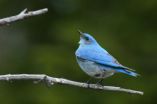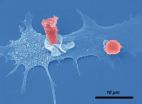(Press-News.org) NASA's Terra satellite passed over Tropical Storm Gordon as it continues to spin up in the North central Atlantic Ocean, and revealed the storm has become less symmetric, indicating it is being battered by wind shear.
When Terra passed over Gordon on August 16, 2012 at 10:25 a.m. EDT (1425 UTC) the Moderate Resolution Imaging Spectroradiometer (MODIS) instrument captured a visible image of the storm. The image showed that the bulk of Gordon's clouds were pushed to the north and northeast as a result of southwesterly wind shear. The MODIS image showed what appeared to be a higher, rounded area of thunderstorms surrounding the center, where the most powerful storms were located. Outer bands of thunderstorms wrapping from the north to the east also contained higher, strong thunderstorms. The wind shear continued on August 17 and Gordon's clouds became less symmetric.
On Friday, August 17, at 5 a.m. EDT (0900 UTC) Gordon's maximum sustained winds were near 65 mph (100 kmh) with higher gusts. The National Hurricane Center (NHC) noted that Gordon could still become a hurricane briefly over the weekend of August 18-19. Gordon is a small storm with tropical storm-force winds extending 60 miles (95 km) from the center, and mostly to the north-northeast.
Gordon was centered about 1,195 miles (1925 km) west of the Azores near latitude 34.6 north and longitude 48.1 west. Gordon is moving toward the east near 18 mph (30 kmh) and it is expected to continue in that general direction. A large trough (elongated area) of low pressure over the northeastern Atlantic Ocean will steer Gordon a little to the south and east for the next couple of days.
Although Gordon is expected to move over somewhat cooler waters, computer models used by the National Hurricane Center still indicate that Gordon may become a hurricane, if just for a short time over the next couple of days and then transition into an extra-tropical storm before reaching the Azores. The NHC noted that Gordon should be approaching the Azores late Sunday, August 19.
Meanwhile, in the far eastern Atlantic, the low pressure area dubbed System 94L has now developed. It is located near 11.3 North latitude and 17.9 West longitude, just west of the African coast. System 94L is producing an area of disorganized showers and thunderstorms. The NHC gives System 94L a 10 percent chance of developing into a tropical depression over the weekend.
INFORMATION:
NASA sees wind shear affecting Tropical Storm Gordon
2012-08-17
ELSE PRESS RELEASES FROM THIS DATE:
Studies shed light on why species stay or go in response to climate change
2012-08-17
Berkeley — Two new studies by scientists at the University of California, Berkeley, provide a clearer picture of why some species move in response to climate change, and where they go.
One study, published online Monday, Aug. 6, in the journal Global Change Biology, finds that changes in precipitation have been underappreciated as a factor in driving bird species out of their normal range. In the other study, published today (Wednesday, Aug. 15) in the journal Proceedings of the Royal Society B, researchers found a sharp decrease in range for the Belding's ground squirrel, ...
Less commonly prescribed antibiotic may be better
2012-08-17
Highlights
Vancomycin was the most commonly prescribed antibiotic in dialysis patients for treating certain bloodstream infections, but cefazolin was 38% better than vancomycin at preventing hospitalizations and deaths from these infections.
Cefazolin was also 48% better at preventing sepsis.
Hundreds of thousands of Americans develop bloodstream infections every year.
Washington, DC (August 16, 2012) — The antibiotic most commonly prescribed to treat bloodstream infections in dialysis patients may not always be the best choice, according to a study appearing ...
Blood markers reveal severity of common kidney disease
2012-08-17
Highlights
The blood levels of certain abnormal proteins and the antibodies that attack them rise according to the severity of one of the most common diseases of the kidney.
The findings may help in the diagnosis and management of the disease, called IgA nephropathy.
IgA nephropathy can lead to high blood pressure, swelling and, in some cases, kidney failure.
Washington, DC (August 16, 2012) — Increasing blood levels of particular proteins may act as warning signs for patients with one of the most common diseases of the kidney, according to a study appearing ...
What's your lifetime risk of developing kidney failure?
2012-08-17
Highlights
Approximately 1 in 40 men and 1 in 60 women of middle age will develop kidney failure if they live into their 90s.
People with reduced kidney function face an even higher risk.
Kidney failure is on the rise and currently afflicts 2 million people worldwide.
Washington, DC (August 16, 2012) — How likely are middle-aged adults to develop kidney failure during their lifetime? A study appearing in an upcoming issue of the Journal of the American Society of Nephrology (JASN) provides some insights, which may be used to help set priorities related to kidney ...
Psychopaths get a break from biology
2012-08-17
SALT LAKE CITY, Aug. 16, 2012 – A University of Utah survey of judges in 19 states found that if a convicted criminal is a psychopath, judges consider it an aggravating factor in sentencing, but if judges also hear biological explanations for the disorder, they reduce the sentence by about a year on average.
The new study, published in the Aug. 17, 2012, issue of the journal Science, illustrates the "double-edged sword" faced by judges when they are given a "biomechanical" explanation for a criminal's mental disorder:
If a criminal's behavior has a biological basis, ...
Mouse study finds clear linkages between inflammation, bacterial communities and cancer
2012-08-17
What if a key factor ultimately behind a cancer was not a genetic defect but ecological?
Ecologists have long known that when some major change disturbs an environment in some way, ecosystem structure is likely to change dramatically. Further, this shift in interconnected species' diversity, abundances, and relationships can in turn have a transforming effect on health of the whole landscape – causing a rich woodland or grassland to become permanently degraded, for example – as the ecosystem becomes unstable and then breaks down the environment.
For this reason, it ...
Is too much brain activity connected to Alzheimer's disease?
2012-08-17
High baseline levels of neuronal activity in the best connected parts of the brain may play an important role in the development of Alzheimer's disease. This is the main conclusion of a new study appearing in PLoS Computational Biology from a group at VU University Medical Center in Amsterdam, the Netherlands.
In recent times, it has become clear that brain activity patterns change at an early stage in Alzheimer's disease. Moreover, there is reason to believe that, instead of being the consequence of structural damage, they might be the cause: recently, a direct influence ...
Organisms cope with environmental uncertainty by guessing the future
2012-08-17
In uncertain environments, organisms not only react to signals, but also use molecular processes to make guesses about the future, according to a study by Markus Arnoldini et al. from ETH Zurich and Eawag, the Swiss Federal Institute of Aquatic Science and Technology. The authors report in PLoS Computational Biology that if environmental signals are unreliable, organisms are expected to evolve the ability to take random decisions about adapting to cope with adverse situations.
Most organisms live in ever-changing environments, and are at times exposed to adverse conditions ...
Virus throws a wrench in the immune system
2012-08-17
The cytomegalovirus (CMV) is a member of the herpesvirus family. Although most people carry CMV for life, it hardly ever makes them sick. Researchers from the Helmholtz Centre for Infection Research and from the USA have now unveiled long term consequences of the on-going presence of CMV: Later in life, more and more cells of the immune system concentrate on CMV, and as a result, the response against other viruses is weakened. These research results help to explain why the elderly are often more prone to infectious diseases than young people.
The viral immunologist Professor ...
New form of carbon observed
2012-08-17
Washington, D.C. — A team of scientists led by Carnegie's Lin Wang has observed a new form of very hard carbon clusters, which are unusual in their mix of crystalline and disordered structure. The material is capable of indenting diamond. This finding has potential applications for a range of mechanical, electronic, and electrochemical uses. The work is published in Science on Aug. 17.
Carbon is the fourth-most-abundant element in the universe and takes on a wide variety of forms—the honeycomb-like graphene, the pencil "lead" graphite, diamond, cylindrically structured ...



